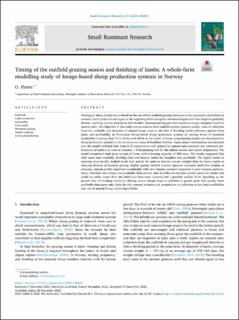| dc.contributor.author | Flaten, Ola | |
| dc.date.accessioned | 2023-01-09T12:58:55Z | |
| dc.date.available | 2023-01-09T12:58:55Z | |
| dc.date.created | 2023-01-02T11:27:18Z | |
| dc.date.issued | 2022-12-30 | |
| dc.identifier.citation | Small Ruminant Research. 2022, 219 . | en_US |
| dc.identifier.issn | 0921-4488 | |
| dc.identifier.uri | https://hdl.handle.net/11250/3041989 | |
| dc.description.abstract | Norwegian sheep production is based on the use of free outfield grazing resources in the mountains and forests in summer. Lamb prices are strongest at the beginning of the slaughter season in August and then begin to gradually decline, reaching a lower plateau in mid-October. Seasonal pricing provides incentives to get slaughter lambs to market early. The objective of this study was to examine how outfield summer pasture quality, time of collection from the outfields, and inclusion of annual forage crops in the diet of finishing lambs influence optimal farm plans and profitability in Norwegian forage-based sheep production systems at varying levels of farmland availability (varying from 15 to 25 ha with 20 ha as the basis). A linear programming model was developed for sheep production systems in the mountainous areas of Southern Norway. Input-output relationships incorporated into the model included data from field experiments with grasses for annual and perennial use, observed performance of lambs and ewes at pastures, a feed planning tool for the indoor season, and expert judgements. The model maximised total gross margin of farms with a housing capacity of 200 ewes. The results suggested that with more land available, drafting older and heavier lambs for slaughter was profitable. The lighter lambs at weaning were usually drafted much later and at the same or heavier carcass weights than the heavy lambs at weaning because of seasonal pricing. Higher quality outfield summer pastures increased lamb live weights at weaning. Annual profits improved considerably with rich summer pastures compared to poor summer pastures. Early collection was always less profitable than normal time of collection because greater prices for lambs sold could not offset losses from the additional feed costs incurred and a possibly smaller flock. Speeding up the growth rate of finishing lambs by offering annual forage crops in addition to grazed grass was usually more profitable than grass only. Only for rich summer pastures and normal time of collection at low land availability was use of annual forage crops unprofitable. | en_US |
| dc.description.abstract | Timing of the outfield grazing season and finishing of lambs: A whole-farm modelling study of forage-based sheep production systems in Norway | en_US |
| dc.language.iso | eng | en_US |
| dc.publisher | Elsevier B.V. | en_US |
| dc.relation.uri | https://doi.org/10.1016/j.smallrumres.2022.106892 | |
| dc.rights | Navngivelse 4.0 Internasjonal | * |
| dc.rights.uri | http://creativecommons.org/licenses/by/4.0/deed.no | * |
| dc.title | Timing of the outfield grazing season and finishing of lambs: A whole-farm modelling study of forage-based sheep production systems in Norway | en_US |
| dc.title.alternative | Timing of the outfield grazing season and finishing of lambs: A whole-farm modelling study of forage-based sheep production systems in Norway | en_US |
| dc.type | Peer reviewed | en_US |
| dc.type | Journal article | en_US |
| dc.description.version | publishedVersion | en_US |
| dc.rights.holder | © 2022 The Author(s) | en_US |
| dc.source.pagenumber | 12 | en_US |
| dc.source.volume | 219 | en_US |
| dc.source.journal | Small Ruminant Research | en_US |
| dc.identifier.doi | https://doi.org/10.1016/j.smallrumres.2022.106892 | |
| dc.identifier.cristin | 2098701 | |
| dc.relation.project | Norges forskningsråd: 208036 | en_US |
| dc.relation.project | Norges forskningsråd: 281251 | en_US |
| dc.source.articlenumber | 106892 | en_US |
| cristin.ispublished | true | |
| cristin.fulltext | original | |
| cristin.qualitycode | 1 | |

